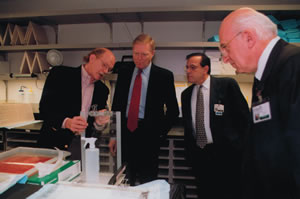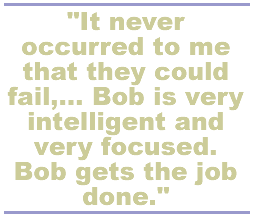
Attending that meeting was Nobel Laureate James Watson, who in the 1950s, along with Francis Crick, discovered the helical structure of DNA. Watson was organizing efforts in various labs to map other organisms-including the human-in a project that would later be known as the Human Genome Project. Looking over their work, he became convinced that these were the men who would be able to sequence the human genome.
"It never occurred to me that they could fail," Watson says in retrospect. "Bob was very farsighted at a time when some people did not think genome science was real science. Bob is very intelligent and very focused. Bob gets the job done."
Waterston had mixed feelings about the project. "Muscle is a very fine field and someone else could do the sequencing," he remembers thinking. "But it was clear there had to be a U.S. component, and because of my work on the map, I was the logical fall guy."

Genetics pioneer Robert Waterston (left) explained some sequencing equipment to Rep. Richard Gephardt, former Democratic leader in the U.S. House of Representatives, when Gephardt visited Waterston's lab in St. Louis. Photo courtesy of Washington University in St. Louis.
Joining the team in St. Louis was Philip Green. Green was "incredibly important" to the Human Genome Project, Watson says, in part for developing computer programs still used for sequencing DNA.
Ultimately, the sequencing center at Washington University would run machines 24 hours a day, with a staff of 300. The center played key roles in the sequencing of the worm, yeast, human and, in the winter of 2002, mouse genomes.
Throughout the process, Waterston has been among those who have demanded that the data be publicly available and easily accessible for researchers around the world, without cost. In 1998, a private company, Celera, announced plans to sequence the human genome. To make back its investment, it decided to charge for access to the human genome sequence.

The challenge to public access led to a "ramping up" of the government effort. At about this time, fate entered again. In the late fall of 1998, Waterston was diagnosed with colon cancer.
"This happened at about the worst possible time," Waterston says. He had a course of radiation and chemotherapy before a successful surgery in April 1999, just as the sequencing effort was reaching its highest gear. While convalescing at home, Waterston set up a "mini-office" and stayed in touch via conference calls. Sulston says: "As so often before, Bob dwarfed everyone with his sheer ability to cope."
But while Waterston set aside time to recover, he also continued his work. "Part of me felt I should not give in," Waterston says.
"Bob recognized that there was a threat to the public availability of the human genome sequence, and he adjusted accordingly," says Marco Marra, a Waterston protégé who now directs the sequencing center at the University of British Columbia. "He did what he could to increase the speed on both sides of the pond. He accepted it as a challenge